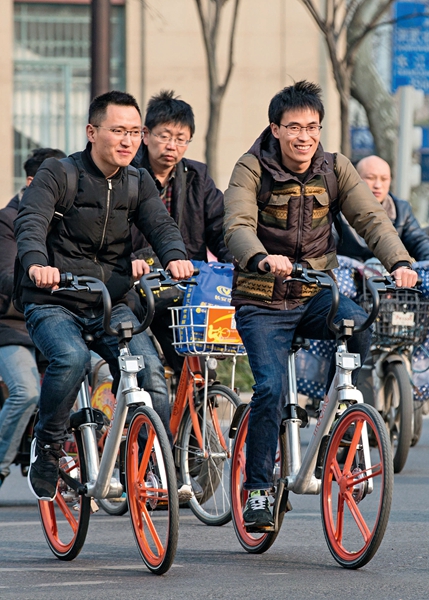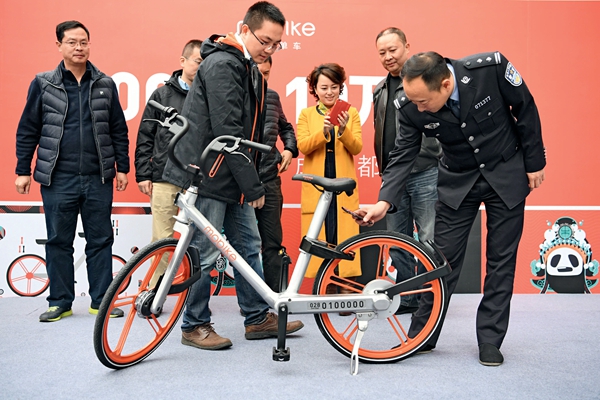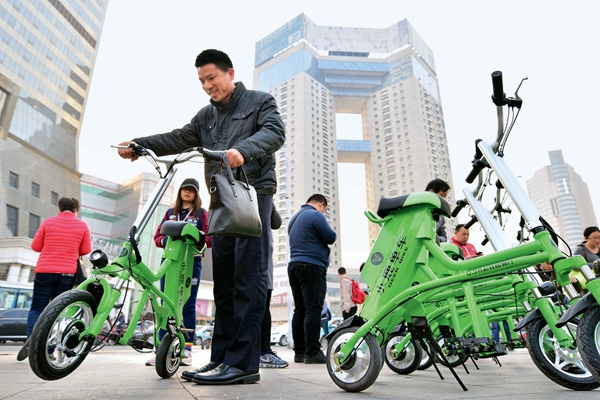The New Bike Sharing Concept for Urban Commuters
China Today, April 26, 2017 Adjust font size:
Shanghai saw the launch last April of the bike-sharing start-up MoBike’s fleet of shared, station-free bikes, distinct for their app-activated rear-wheel locks. Their aim to provide urban dwellers with affordable, convenient, short-distance transportation, they were an immediate success. A few months later they made their debut in Beijing, and soon after in Chengdu and Guangzhou. They were such a hit in Shenzhen after a 30-day trial that the fleet there was expanded to 30,000. Many cities have designated special parking zones for the shared bikes.
|
|
|
Shared bikes prevail in big cities because they are convenient and environmentally friendly. |
MoBike extended its business coverage to 20 cities on February 17, 2017 with the launch of its bicycles in Haikou, provincial capital of Hainan. The company also has its eye on other cities on Hainan Island. MoBike CEO Wang Xiaofeng revealed that the company’s present target is to operate a fleet of 100,000 shared bikes in each city.
Collective Memory
Several decades ago, when China was known as the “kingdom of bicycles,” local residents set great store by their two-wheeled personal transportation. Back in the 1970s, a bicycle meant much more than simply a cheap way of traveling to work, rather signifying a family’s level of affluence. Along with a watch and a sewing machine, a bicycle was one of the “three prerequisites” for tying the knot. When China’s economy started to revive in the late 1970s after the launch of the reform and opening-up drive, bikes generally became more affordable. City roads crawled with cyclists at rush hours, and the silvery tinkle of bicycle bells pervaded streets and alleys. Since the turn of the 21st century, however, cars, considered more labor-saving and efficient, as well as comfortable, have steadily superseded human-powered two-wheeled transportation. Today, as autos become ever more accessible to Chinese families, bicycles are scarcely apparent in urban areas.
Ministry of Public Security Traffic Management Bureau statistics show that, as at the end of 2016, China’s inventory of motorized vehicles numbered 290 million, among which cars exceeded 194 million – a world No. 2 ranking. The number of bicycles, meanwhile, has shrunk. Their percentage as a mode of local transportation dropped from 62.7 percent in 1980 to 38 percent in 2000, to a miniscule 11.9 percent in 2014.
|
|
|
A police officer well-known in Chengdu, capital of Sichuan Province, unlocks a shared bike, taking the MoBike fleet in the city to 100,000. |
The convenience of cars is somewhat counterbalanced by their serious downside effect of traffic congestion and air pollution. Beijing is now the country’s undisputed “a traffic jam capital.” This undesirable accolade throws into sharp relief the merits of the low-carbon, environmentally friendly, resource-saving bicycle. But although both urban governments and individuals are keen to restore two wheeled transportation, commuting distances present a problem; they are often far longer than what can reasonably be traveled by bicycle. Some people have considered getting round it by traveling part way by bus or subway and part by bike. But making a smooth connection between public transportation and bicycle riding is a common stumbling block to this solution.
The recent advent of shared bikes marks a significant progression from the public bicycle rental service that Beijing first offered around 2008. As of November 2015, the city’s public bicycles had been ridden an average 300,000 times each on a daily basis, and more than 400,000 “smart” public bicycle renting cards had been issued, according to the Beijing Evening News. Although these figures reflect the enormous public demand for bicycles, the red tape involved, particularly the documentation required to apply for a rental card, generates frequent complaints. Such bikes must also be rented from and returned to franchised stations, which are often respectively empty or full.
Shared Bikes Are Go
MoBike cuts through this red tape with a smartphone app that covers all steps in the rental service, from finding an available bike to payment. Meantime, the station-free aspect considerably simplifies matters. Sharers can leave their bikes at any public bicycle parking lot, so freeing them up for the next cyclist.
Wei Bo from Beijing had her first MoBike experience during a trip to Shanghai. “I was wearing high heels to look good in photos, but it wasn’t a good idea for sightseeing,” she admitted. “As my feet were killing me, and I’d heard about renting shared bikes, I thought I’d give them a try.” Unfamiliar with the city, it took her a while to find an available bike. But as soon as she had registered online and pedaled out on to Shanghai’s byways, her efforts were rewarded. “I cycled along the banks of the Huangpu River. Becoming familiar with a city at your own pace in a ‘light-footed’ way” is a wonderful experience.”
|
|
|
The launch of the first fleet of 500 shared electric bikes in Tianjin on March 16, 2017. |
A couple of months later, Wei was happy to see Beijing join the shared bike network. “My home is only one bus stop from my company. But getting there takes half an hour on foot and even longer by bus at rush hour,” Wei said. Cycling seemed the best option, but complicated registration requirements had always put her off renting a public bike. “Using a shared bike ensures that I get to the office on the dot of 9:00 am.”
The MoBike design concept removes any worries cyclists may have about flat tires or falling chains, and a sensor in the rear-wheel lock keeps thieves at bay. The company upgrades its products according to user feedback, and its bike-sharing system has now reached the third generation. Having reduced the weight of the bicycle and placed a basket at the front, the solar panels it has installed also save energy. MoBike seeks, through constant innovation and exploration, the perfect user experience that will restore the popularity of urban cycling.
At the end of 2016, MoBike improved its first-generation product with its launch of the MoBike Lite which, because it is lighter, saves on manufacturing costs. Meantime, the fee has been reduced from one yuan per 30 minutes to 0.5 yuan.
Go Green on Two Wheels
As most people are keen to “go green,” the bike-sharing business is flourishing. MoBike and its peers including ofo, U-Bicycle, and Xiaoming, are expanding as they compete. In a sense, this rivalry is beneficial because it motivates companies to constantly improve their products and services.
The collective memory of bicycles cherished by generations of Chinese people was displaced by the blind contemporary stress on “high efficiency.” But environmental protection awareness and the priority given to quality of life is reviving it. What’s more, the historical affection for bikes and cycling is a good foundation on which to refresh and upgrade this non-motorized transportation.
The government is expected to set up the relevant facilities and infrastructures to encourage more people to commute on two rather than four wheels. For instance, bike lanes are essential for cyclist safety, and many cities have plans to improve cyclists’ access in this respect. Various projects with this in mind, such as the redesign of bike lanes to avoid automobile incursions, are expected in the capital. By the end of 2020, Beijing will own a 3,200-km network of bike paths.
Meanwhile, local authorities are also offering shared bike services. Zision, a project to reuse abandoned bikes, has been jointly developed by Haidian District government and Edaibu Technology Company. Since last November, the company has recycled the unwanted bikes of local Haidian residents in 29 pilot communities. Together with those abandoned on streets, they are repaired using new technologies. The first batch of 20,000 bicycles is now in use in the district. The project has thus contributed to the city’s shared bike service resources and also eradicated the long-standing eyesores of abandoned bikes. The Beijing municipal government intends to encourage bike riding to the extent where it accounts for 16 percent of local transportation means by 2020, and for more than 20 percent by 2030.


